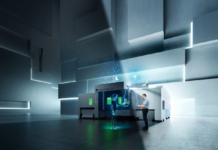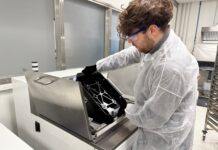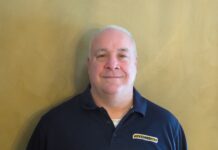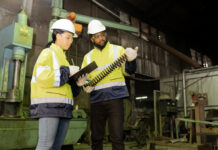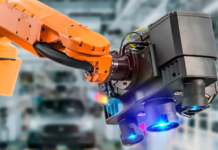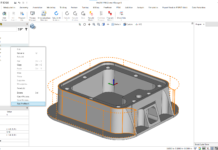
• Groundbreaking ceremony for new location for 3D metal printing in Lichtenfels
• Expansion of activities for research, development, and production at Concept Laser
With this groundbreaking, GE (NYSE: GE) and Concept Laser lay the foundation for a new facility in Lichtenfels, Germany. In the future, the 3D Campus will unite research and development along with production, service, and logistics. The new offices should be ready for move-in early 2019, and around 40,000 square meters will provide room for about 500 employees. The future machine production capacity will be four times higher than today. This will make Concept Laser’s Lichtenfels facility a global GE center for the production of 3D metal printing machines. About 105 million euros will be invested into the location.
The 3D Campus will accommodate the strong growth of Concept Laser in recent years and make room for further expansions. Ilse Aigner, Bavarian Minister of Economic Affairs and Media, Energy, and Technology came to Lichtenfels for the celebrations: “The investment made by GE and Concept Laser is a clear statement of confidence in the location. It secures jobs and provides a vital boost to growth in the region. The 3D Campus will create a center for 3D metal printing that offers real added value for the whole of Bavaria. 3D printing is becoming more prevalent in almost all sectors because it allows lighter, more variable and more stable components to be produced using fewer resources. Additive Manufacturing therefore has an important role to play for Bavaria as a forward-looking industrial location.”
“I am pleased to take the next step in our growth strategy with today’s groundbreaking. We are not only laying the foundation for a new facility, but also creating skilled jobs in the region. Lichtenfels will become a global beacon for industrial 3D printing as the new GE center,” says Frank Herzog, founder and Chairman & Chief Executive Officer of Concept Laser GmbH. “Today is a good day for Lichtenfels and the region. I would like to thank everyone involved for making this advancement possible.”
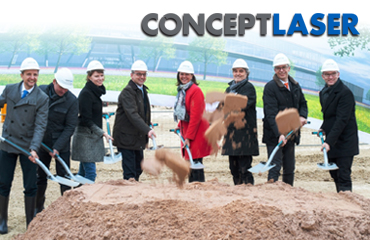 Three-thousand-eight-hundred truck loads of cement will be laid in the 3D Campus. Add to that 3,600 tons of steel, which corresponds to a weight of 6.5 fully loaded A380 Airbus aircraft. The posts required for the building add up to a total length of 5.9 kilometers. The location for the 3D Campus in the new Seubelsdorf/Lichtenfels industrial park combines ideal characteristics, such as having a great location and connections. The outstanding growth of Concept Laser in recent years is reflected in the currently fragmented office situation – and the current facilities Lichtenfels/Schney location cannot be expanded any further.
Three-thousand-eight-hundred truck loads of cement will be laid in the 3D Campus. Add to that 3,600 tons of steel, which corresponds to a weight of 6.5 fully loaded A380 Airbus aircraft. The posts required for the building add up to a total length of 5.9 kilometers. The location for the 3D Campus in the new Seubelsdorf/Lichtenfels industrial park combines ideal characteristics, such as having a great location and connections. The outstanding growth of Concept Laser in recent years is reflected in the currently fragmented office situation – and the current facilities Lichtenfels/Schney location cannot be expanded any further.
Additive manufacturing (also called 3D printing) involves taking digital designs from computer aided design (CAD) software, and building them on an additive machine, layer by layer from metal powder. Additive components are typically lighter, more durable and more efficient than traditional casting and forged parts because they can be made as one piece, requiring less welds, joints and assembly. Because additive parts are essentially “grown” from the ground up, they generate far less waste material. Freed of traditional manufacturing restrictions, additive manufacturing dramatically expands the design possibilities for engineers. Additive manufacturing is a transformative technology – part of the new world of advanced manufacturing. Combined with an entirely new approach to industrial design, additive can help transform businesses by improving their products, manufacturing operations and opening up entirely new business models.
About Concept Laser GmbH
Concept Laser GmbH, which was founded in 2000 by Frank Herzog, is one of the world’s leading providers of machine and plant technology for the 3D printing of metal components. Since December 2016, Concept Laser has been part of GE Additive, a division of the world’s leading digital industrial enterprise General Electric (GE). GE Additive was founded in 2016 and acquired 75% of the company shares of Concept Laser, among others.
The technology driver is the patented LaserCUSING® process from Concept Laser. The powder-bed-based laser fusing of metals – opens up new freedoms when it comes to configuring components and also permits the tool-free, economic fabrication of highly complex components in fairly small batch sizes. The company’s customers come from many different sectors of industry, for example medical and dental technology, the aerospace industry, toolmaking and mold construction, the automotive industry and the watch and jewelry industry. Concept Laser’s 3D metal printers process among other materials powder materials of stainless steel and hot-work steels, aluminum and titanium alloys and – for jewelry making – precious metals.
In addition to first-class additive production plants, also from Concept Laser, GE Additive offers materials and extensive development consulting for various industries. GE Additive is dedicated to the further development and transformation of the industrial sector with software-defined plants as well as networked, adaptable and forward-looking solutions.
LaserCUSING® background information
The patented LaserCUSING® process from Concept Laser is used to create high-precision mechanically and thermally resilient metallic components. The term “LaserCUSING®,” coined from the C in Concept Laser and the word FUSING, describes the technology: The fusing process generates components layer-by-layer using 3D-CAD data.
In this process, fine metal powder is fused locally by a high-energy fiber laser. The material solidifies after cooling. The contour of the component is created by redirecting the laser beam using a mirror redirection unit (scanner). The component is built up layer by layer (with a layer thickness of 15 – 500 μm) by lowering the bottom of the build chamber, applying more powder and then fusing again.

